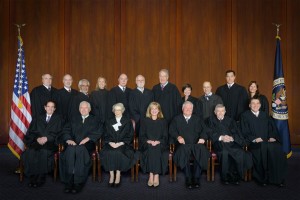
Front (L to R) Judges Clevenger, Plager, Newman, Prost, Mayer, Lourie, and Schall. Back (L to R) Judges Hughes, Taranto, Reyna, Moore, Linn, Bryson, Dyk, O'Malley, Wallach, Chen, and Stoll. (Click on image for a larger view).
The judges are seated according to seniority/tenure on the court. For example, Chief Judge Prost is seated in the middle of the front row, as the most senior. To her right is Judge Newman who has the longest tenure on the court. To Chief Judge Prost’s left is Judge Mayer, who has the second longest tenure on the court after Judge Newman. The seating continues to alternate about Chief Judge Prost by tenure. In the back row, the arrangement by tenure continues and is centered about Judge Bryson. The court’s two newest appointees, Judges Hughes and Stoll, bookend the back row.